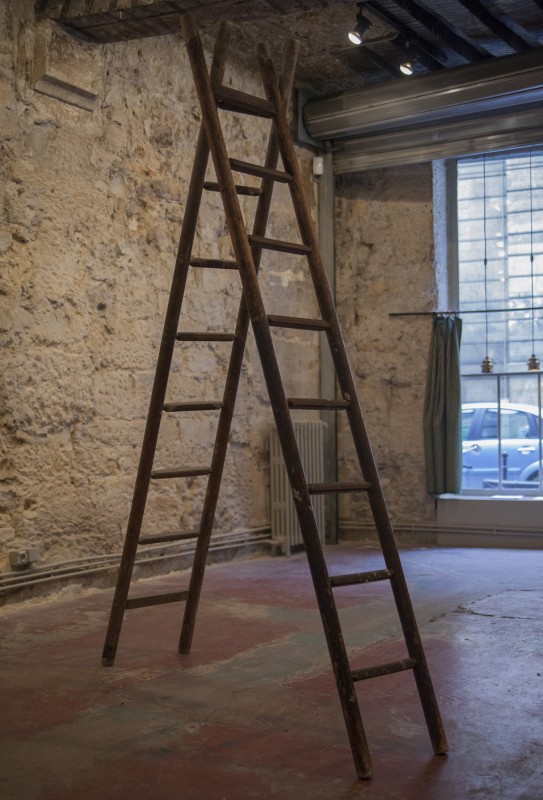First Chapter : Des Absents
Cercle de la Horla
16, rue du Vertbois 75003 Paris
October 23 – December 17, 2015
(Read part one of the report here)
Chapitre Premier : Des Absents ended on the 17th of December, at precisely 8:30pm. A few days later, I took the train to meet artist Edgar Sarin in his Normandy studio, far from all beings, as he says, to talk about the whole experience. I’ve never witnessed so much movement within a show. One day the pieces were on the walls, hung upside down, another day on the floor; sometimes there were none, as for Draught—the night during which Sarin took visitors inside the gallery before opening two opposite windows to create a delicate air stream. Very vivid indeed. We therefore decided to highlight here a few of these events and further discuss their aftermath, as this experience was built to be studied.
The set that aroused me the most was when all the artworks were gathered in the middle of the room. This layout spread a delicate and solemn atmosphere, almost like that of a cemetery. This setting incidentally occurred right after the attacks of the 13th of November: a time during which the city of Paris was still anesthetized and its climate very grave. Moreover, one could see the back of each artwork, a very interesting point of view rarely seen in galleries.

Screenshot of the surveillance camera during the performance, Waiting for a sign from you, 2015. Photo credits: Cercle de La Horla
Beyond just the setup of the artworks, the space had been designed to present more performative works. Waiting for a sign from you is one of the pieces created in situ that caught my attention the most. Sarin took a whole morning to toast 122 slices of white bread, hoping to stumble upon the face of Mother Mary on one of them. Nevertheless, one toast over the 122 hadn’t been toasted—toast number 87—concealing all the chances to get the sacred image. We can notice here a link between the works of Bas Jan Ader and Edgar Sarin, in which the artist is almost set as a prophet, a non-religious one obviously, as someone seeking an invisible sacred essence that could only potentially manifest itself.
The aim of this first Horla exhibition was to reach the Harmonic State, a setting within which each artwork found its proper space among the others: the perfect and therefore most natural exhibition. Sarin says this state “cannot be discussed as it is the first sustainable state to be chronologically reached and however, of theoretical importance, this show made me realize it was not to be witnessed nor remembered. The process to reach it is what is to be exhibited.” According to Edgar Sarin, a gallery is a place to show research, a dynamic process towards perfection.

Dissonant music performance in front of the gallery. Photo credits: Jamie Lozoff
Sarin also confided in me that this experience helped him build the base of what he calls the Accidental Fetishism: a consideration of certain objects emitting something, as a radioactive entity, throughout space and time. “A new kind of entity appeared to me—entities that had always been surrounding me. Only a few items can be taken from their original society and keep on radiating, those are the ones. And there are no accidents in Accidental Fetishism; those entities are meant to sustain.” Therefore, some random items from the show have been kept by Sarin, such as a little industrial bag of sugar mistakenly unfilled.
I’ve seen in this show a certain naiveté, as if our uprooted generation had to recreate its own rules, its own essence. One artist in the show, Nicholas Korody, picked places in L.A. to take samples of soil and systematically shipped them to the Cercle de La Horla throughout the show, which can be seen as an innocent way to recreate and database knowledge: just like the Ryan H. pieces, the 99 representations of the Bicephalous—very rough, almost violent, yet ingenuous archiving of his subversive wanderings in the city. This piece was, by the way, the first one to be partially destroyed once the Harmonic State was reached.

Sneak peek of the video showing Ryan H. partially destroying his piece. Photo credits: Cercle de La Horla
Sarin also evoked the notion of effort which he placed at the center of his process in creating the exhibition. He is aiming to build a new kind of dialog between the visitor and the exhibition, a post-digital dialectic in which the visitor, by any means, has to produce something himself, has to make an effort to reach meaning. Sarin’s whole exercise revolves around orchestrating this effort through highlighting the effort flow channels. This idea is directly inspired by the Internet Era within which each single person contributes to a much bigger achievement. Then, one exhibition could be seen as a Wikipedia page.
Now that the first chapter is finished, Edgar Sarin has isolated himself to go through the archives and footage of the show in order to, after a first phase of action, continue the theorization of the Horla paradigms. He, nevertheless, already has an early idea about another iteration of Cercle de La Horla that will take place in a few months in New York and already claims it will be “the most irritating thing ever seen.” To be continued . . .

The Balanced Embrace – Edgar Sarin. Photo credits: Max Dmitrievsky



